[WR]F.A.Q - High Country
Posted by Nick Teynor & Logan Griffith on Aug 5th 2025
I'd venture out to say that there is something for everyone in the high country. There are small fish, [some] big fish, sight fishing with dry flies, streamers, over 4 species of trout, arctic grayling, big lakes, small ponds, pocket water, meadow streams and that's just the fishing! Short hikes, long multi-day backpacking trips, vast star-ridden skies, red rock amphitheatres, solitude and quietness. Oh, and variable weather! Something we haven't been experiencing much of throughout the west this time of year... For us here in Salt Lake City, to have the High Uinta Wilderness, Boulders and a multitude of national forests and high elevation fisheries within a couple hours drive and to get to experience these things is an understated freedom and underutilized resource for many anglers. With over 600 fishable lakes reaching over 13,000 ft. in elevation and countless miles of creeks and streams, the opportunities are endless and I'll be the first to say I don't take enough advantage. As the August heat blankets the valley and our aquatic hatches begin to wane, escaping to higher elevations for a reprieve and some laid back yet exciting fishing is a welcomed shift in focus.
Fishing alpine lake and streams, backpacking, hiking and exploring the wilderness is a beast in and of itself. If you've ever wanted to start exploring, venture further off the beaten path or just catch a new species of fish; this [WR]F.A.Q is for you.
Follow along in our latest Western Rivers Frequent Angling Questions or [WR]F.A.Q's as we tackle some of the basics on getting out and fishing the High Country!
What is the fishing season for High Country lakes and streams?
In short, fishing in the high country starts when the snow and ice is gone, and ends when the snow and ice returns. Decent fishing opportunities can occur as early as mid-June, but usually no earlier than the 4th of July. The creeks and streams can take a moment to come into shape after run-off, but once it [run-off] is over, the fishing for the next 3-4 weeks can be excellent. However, once we are into the hottest time of the year (late July through early September), the little creeks and streams can be too low and too warm to fish. On the flip side, the high country lakes will fish well from ice-off to ice-on, and are excellent options to explore during the hottest days.
What species and size of fish will I find up there?
We’ve got a little bit of everything up in the high country, and even some grand slam possibilities on certain drainages. The most prevalent species that you’ll find are Cutthroat, Brook Trout, Tiger Trout, and Arctic Grayling. The average size of fish is 8”-10” though larger fish are regularly found, and certain lakes can hold trout pushing 20”! Deeper lakes aid in trout's ability to winter over, and along with food sources, is an important factor in growing larger alpine trout.
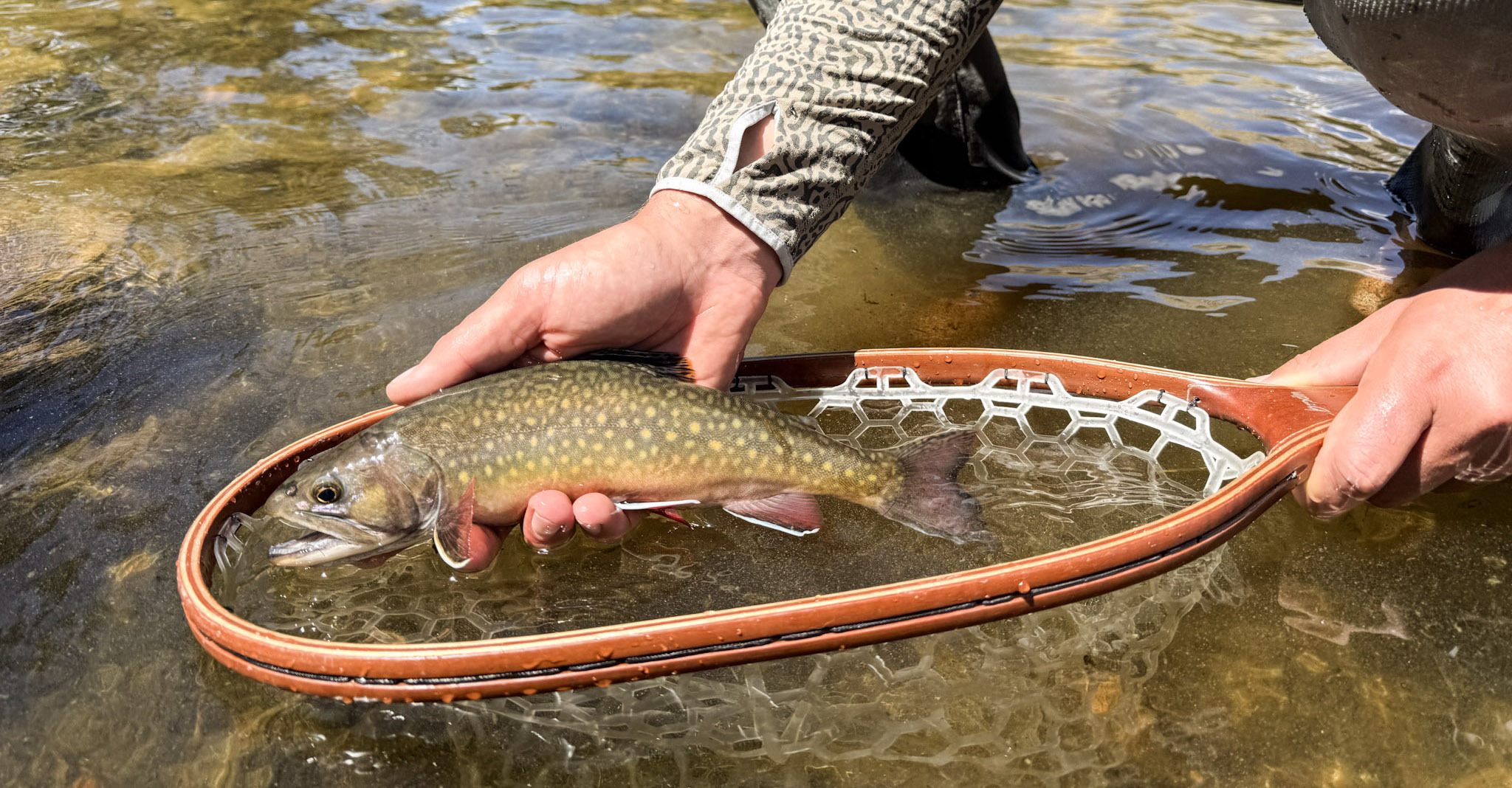
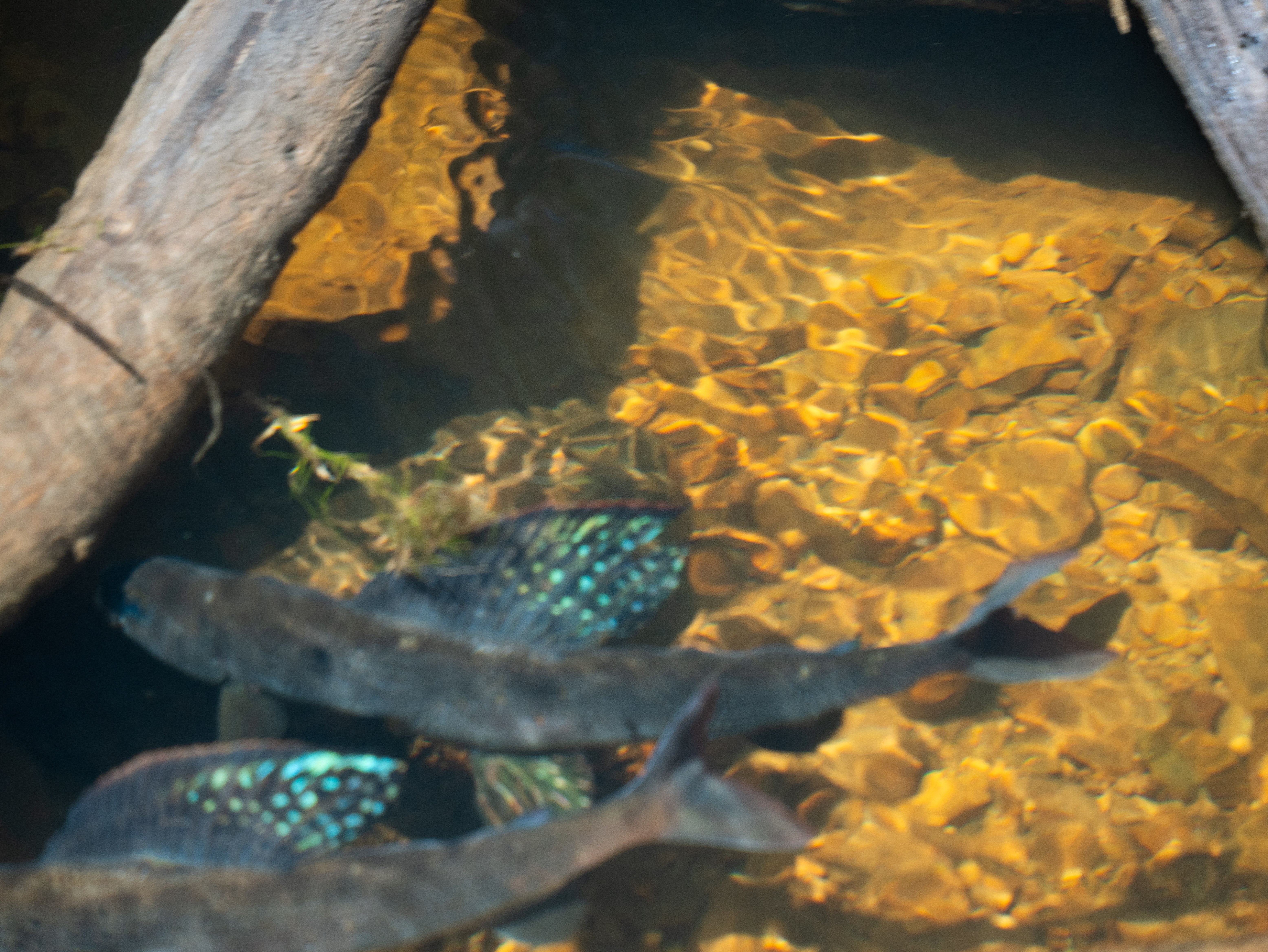
L: A healthy brook trout specimen caught by Logan in a high elevation Uinta lake. R: Spawning Arctic Graying stacked up in the structure Ph: Finn Hall
How do I choose where to go?
A good topographic map of the area you’re interested in fishing, combined with a decent guide book, is the tried and true way to find places to fish in the high-country. However, things in the high country change year to year, and guide books aren’t able to keep up with these changes. A local fly-shop with an up to date fishing report is still probably your best bet, and the state fish and game website can also be a great source of info. The Utah Division of Wildlife Resources and their fishing app is a great source of info for the Uintas or other nearby ranges & areas. They may not have up to date fishing info, but they do list what species of fish are in each lake or drainage, and when they were last stocked, which is incredibly helpful.
Areas like the High Uintas offer such an abundance of fishing options that keeping up with each individual drainage and lake is near impossible. It’s fairly safe to assume that most lakes will fish similarly, and the fly selection should remain consistent throughout the region. It’s not just tight-lipped fly anglers frequenting these areas, so don’t be afraid to snoop around on hiking and backpacking websites for information that is otherwise only gained through first hand experience.
How should I prepare for a day or weekend in the high country?
Anytime you head into the high country, you need to plan ahead. Make sure to scout out and find the trails to where you want to fish on maps or the internet, reserve campground sites or permits ahead of time, and be prepared for the weather to change on a dime. Whenever we are planning trips, we watch the weather like a hawk, and make sure to be prepared for any potential bad weather with the appropriate gear. Unexpected thunder and lightning storms as well as early season snow is not uncommon, and can be dangerous at high elevations. Sunscreen, bug spray, rain jacket, a filter water bottle, base layers, backup socks, head lamp, first aid kit, extra snacks, letting people know where you’re going-these are all smart things to have and do before heading into the high country. While we do have a fair population of black bears here in Utah, I wouldn't say that bear spray is imperative for us. Moose and mountain lions pose greater threats locally and you'll want to be paying close attention for signs of these critters when navigating the backcountry. If you're heading to the Wind Rivers or Greater Yellowstone area, for example, you'll want to be packing some bear spray and taking all of the proper steps for staying safe in grizzly country.
Products like the Patagonia Stealth 3L & Stealth 5L Switch packs are great for packing in distances as they can attach easily to the outside of your daypack and then removed and used as your fishing pack once having arrived at your fishing destination. The Simms Pursuit Shoes and Patagonia Forra Wading Boots are built for hiking and can offer a nice hike-to-fish footwear option for long days of fishing in the backcountry. Other ultralight products that we won’t go to the high country without are the Patagonia Houdini Jacket which is lightly wind and water resistant and can pack down to virtually nothing and the Fishpond Fly Pucks are small, waterproof and secure fly containers that snap together to just bring a smorgasbord of bugs with you.
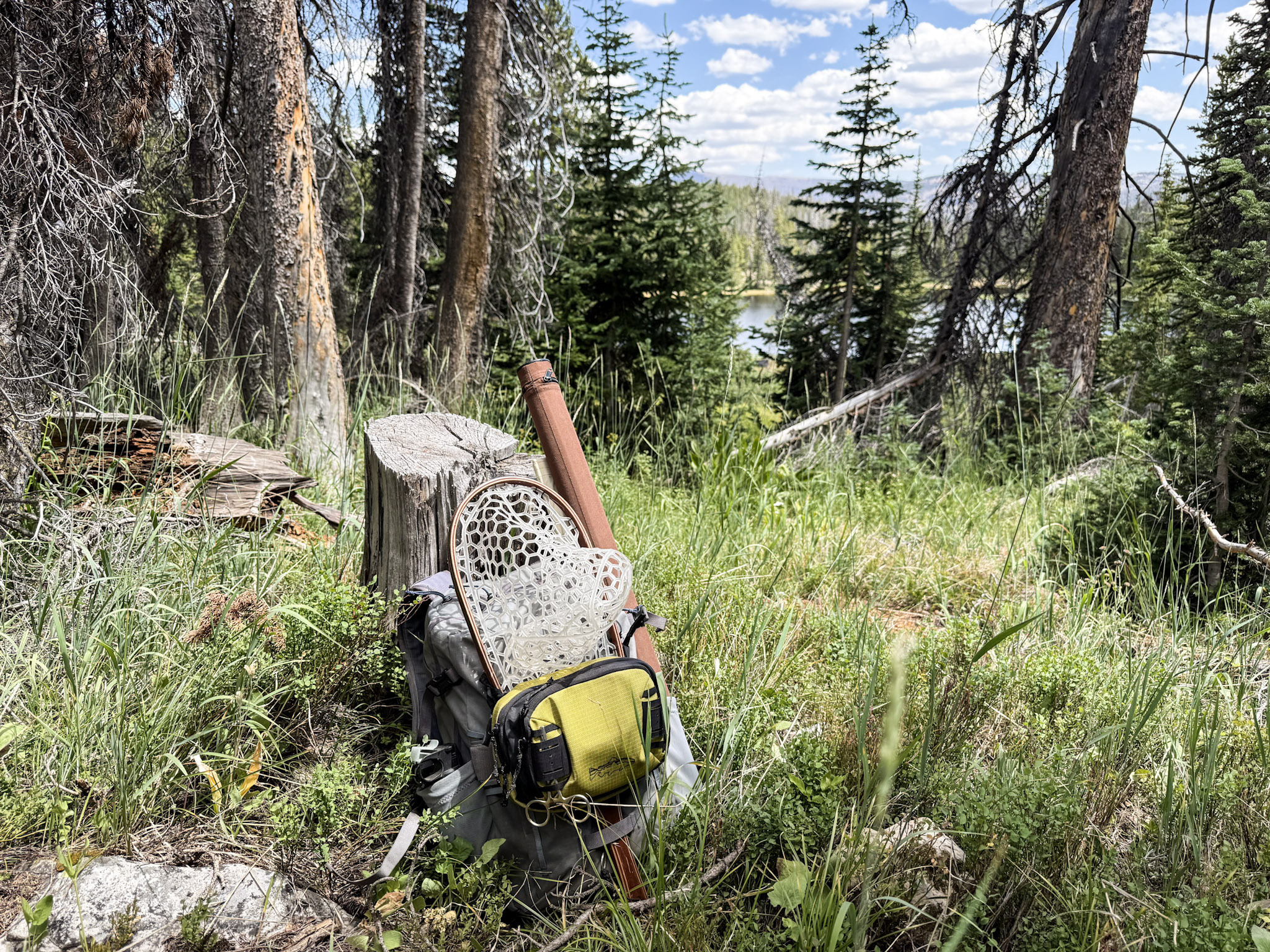
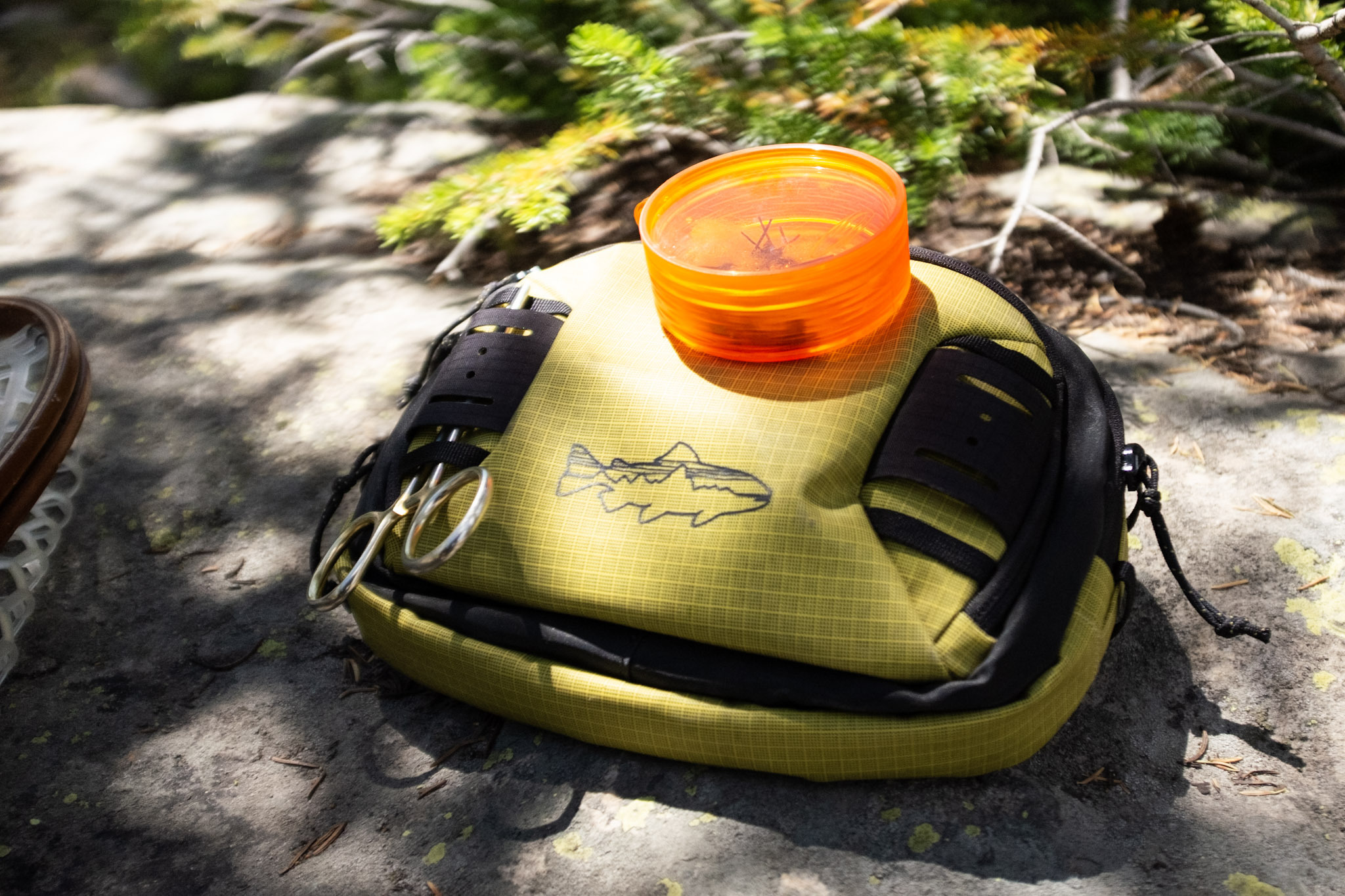
Load up a fly puck and get hiking! These little Patagonia Stealth Switch Packs will connect to the outside of most backpacks and then make a perfect fishing pack by themselves when you reach your destination!
How do I successfully fish a high elevation lake?
You can fish these lakes anyway you want to! If you like to fish dry flies, you can walk around the edges of the lake looking for rising fish, or fish that are cruising closer to the bank, and present your fly to them by casting 3’-6’ feet in front of them. They will either come over and eat your fly, ignore it, or run away if you land your fly too hard on the water. If there are no fish rising, and there is not enough sunlight to spot fish, prospecting with smaller streamer patterns (#8-#14) that imitate leeches and minnows, and keeping your feet moving after a handful of casts can be productive. Fishing a dry-dropper rig, or bobber rig with balanced leeches or nymphs can also work when the dry fly and streamer bite slows down, or when the weather turns from being warm to cold.
As far as what flies to use, and how to pick one, I use a very simple criteria. Brighter the day, brighter the fly. Darker the day, darker the fly. If the weather is cloudy and/or stormy, fish a streamer and focus on fishing around structure. If there are fish rising or cruising close to the shore and surface, fish a dry fly and try to match the fly shape, hook size, and color of your fly to what you think the fish are feeding on. If you see fish cruising, and they won’t eat the dry, a dry-dropper rig with an 18”-36” dropper to match the light conditions can move fish unwilling to come up to the dry.
How do I find fish in a high elevation lake?
Fishing lakes can seem daunting due to the lack of obvious structure that you find in creeks and streams, but in reality, the structure you find fish around in moving water is similar to still water. Key points of structure to focus your fishing in high country lakes and ponds are:
- Rocky Points and rock structure in the water.
- Shady banks with trees hanging over the water, beaver lodges, log jams, stumps and lily pads.
- Drop-offs and shelves where the water goes from shallow to deep. Fish will find most of their food in the shallower water, but will retreat to deep water when threatened, which is why these “transition areas” can be productive.
- Inlet and outlet streams. Inlet streams bring food and oxygen into the lake, which makes them ideal areas to fish around. Outlets allow fish to transition between the lake and the stream, and funnel food into a more concentrated area.
- Weed beds are also great areas to fish around, because the weeds are home to many food items fish in lakes key on, such as mayfly nymphs, scuds, damselfly nymphs, minnows, etc.
Seasons, weather, time of day, and understanding how these things will change when and where the fish will be actively feeding can also help you have more success. Typically, fish will hold closer to the lake's edge during the early season and late season, because that is where a majority of the food is, and the water temps are nice and cool throughout the entire day. However, as the weather gets warmer, fish will drop down into deeper water-especially during the brightest and warmest parts of the day. They will move into shallower water to hunt and feed when the water cools down, and when there is less light on the water, which is why fishing high country lakes in the mornings, evenings, or when there are clouds is usually the most productive during the Summer.
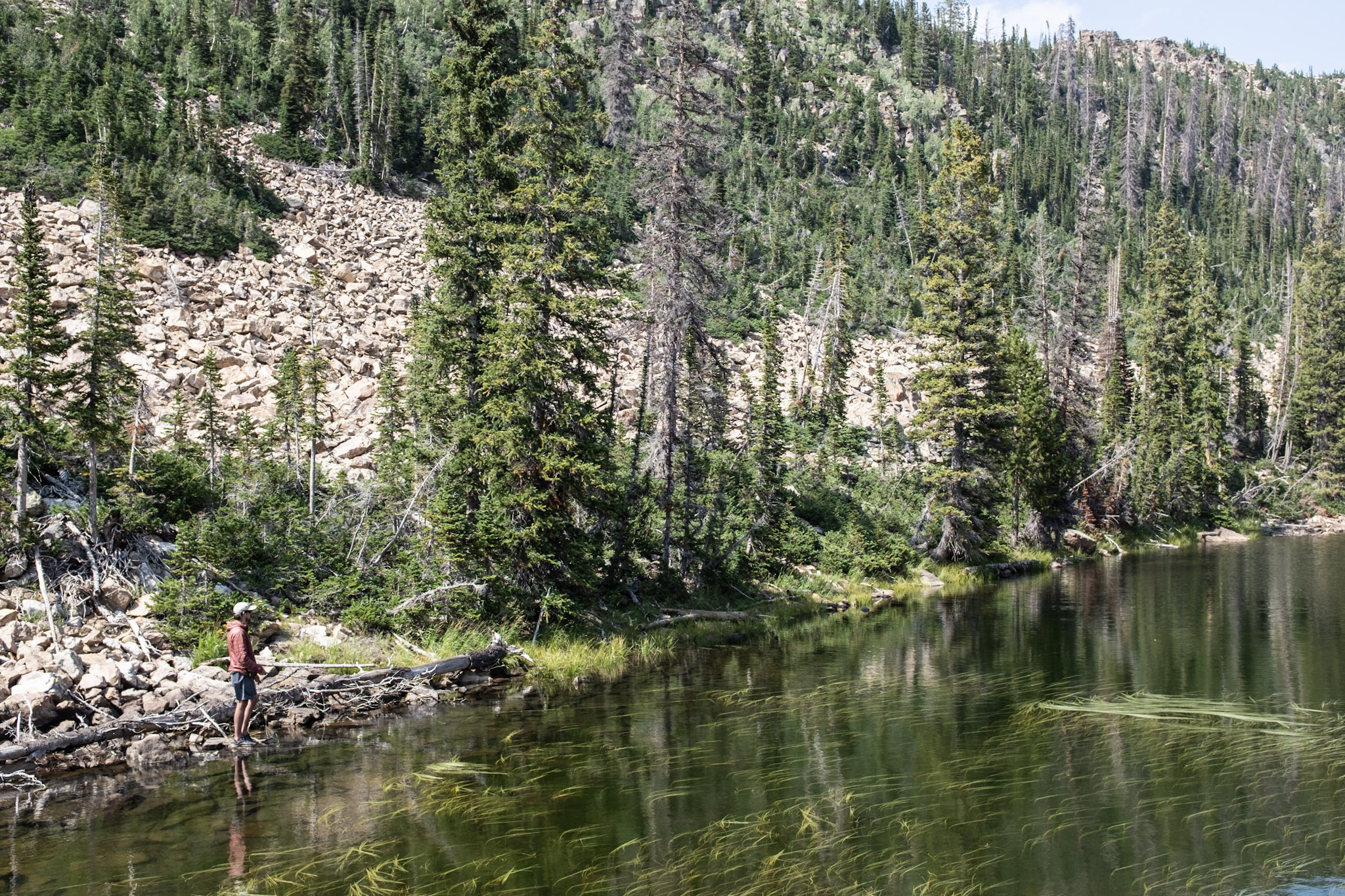
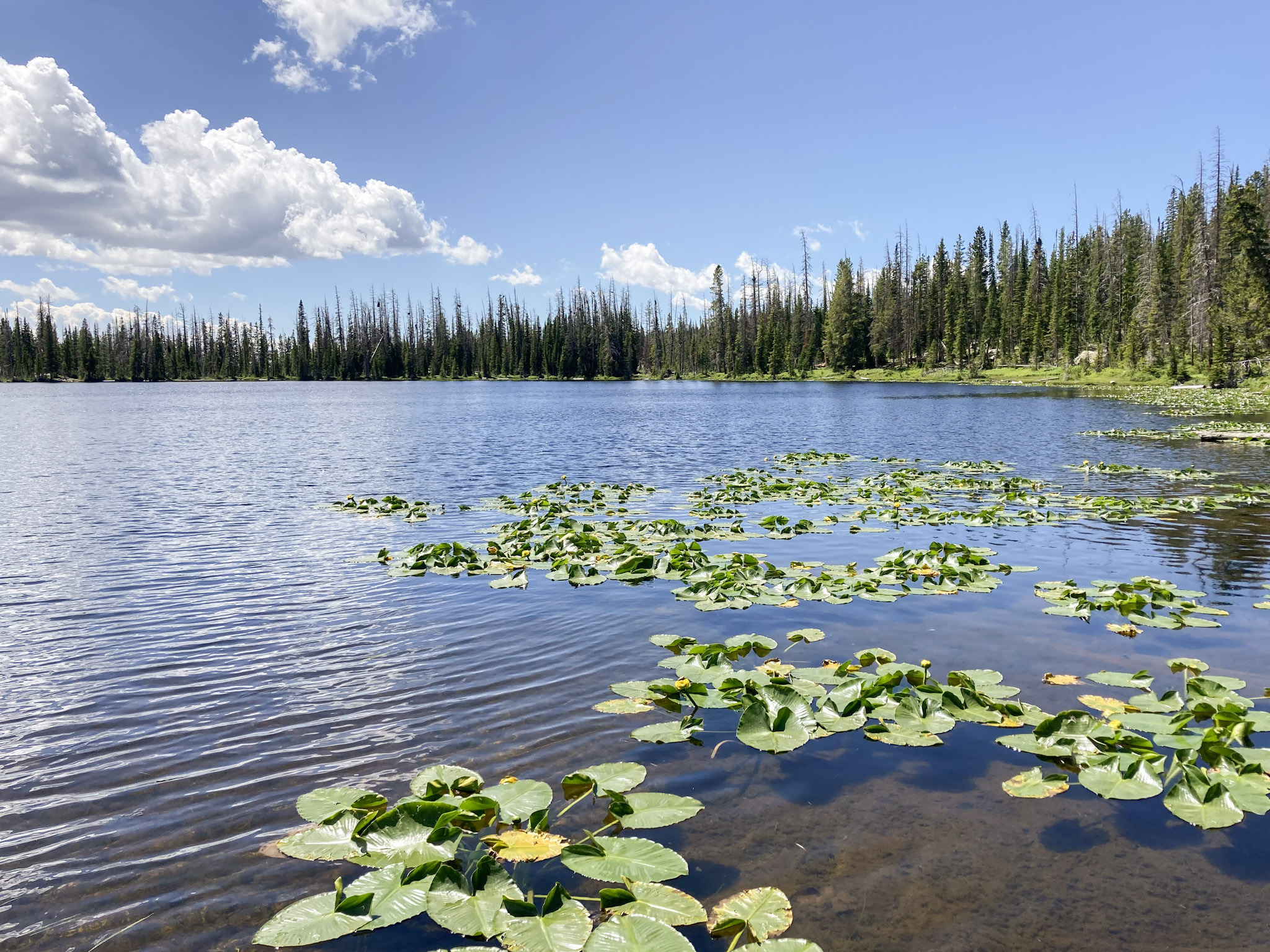
Lily pads and weed beds are the perfect places for high elevation trout to cruise around and feed under cover. Don't be afraid to tap in to your inner bass fisherman and present a fly right in to the center of this structure!
How do I fish a high elevation creek or stream?
How you fish a stream in the high country will vary based on the season. Most of these fisheries are unfishable until the run-off subsides, which is typically around the 4th of July. Once the flows drop, all of the major insect hatches will come off (Mayflies, Caddis, Stoneflies), the trout are very happy, and the fishing is good-great. Once the prime flows are done however, fishing can become tougher. The fish will seek out cool, oxygenated water, deep holes, shady or undercut banks, and the best fishing will usually be in the mornings or evenings.
Fly selection and how you pick your flies for high country streams is similar, if not identical, to the flies you will use in high country lakes. With how low the creeks are this time of year however, fishing a dry fly, or dry-dropper rig with an 18” dropper, will be the most effective. There can still be some caddis or mayflies around, but most of the time all you will need is a variety of attractor dry flies and nymphs in different colors or sizes, and it’s definitely wise to have a variety of terrestrials (i.e. ants, beetles, hoppers, crickets).
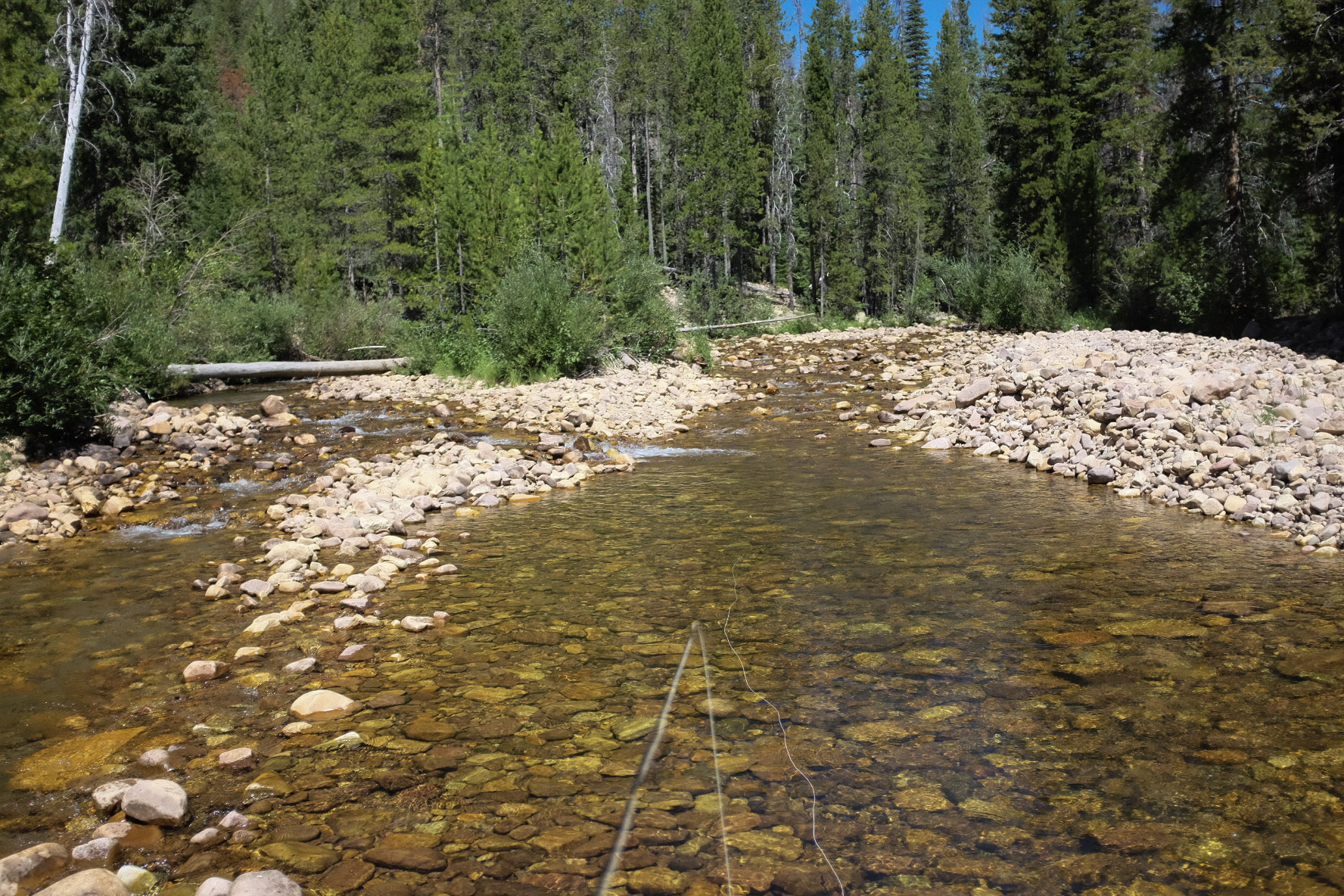
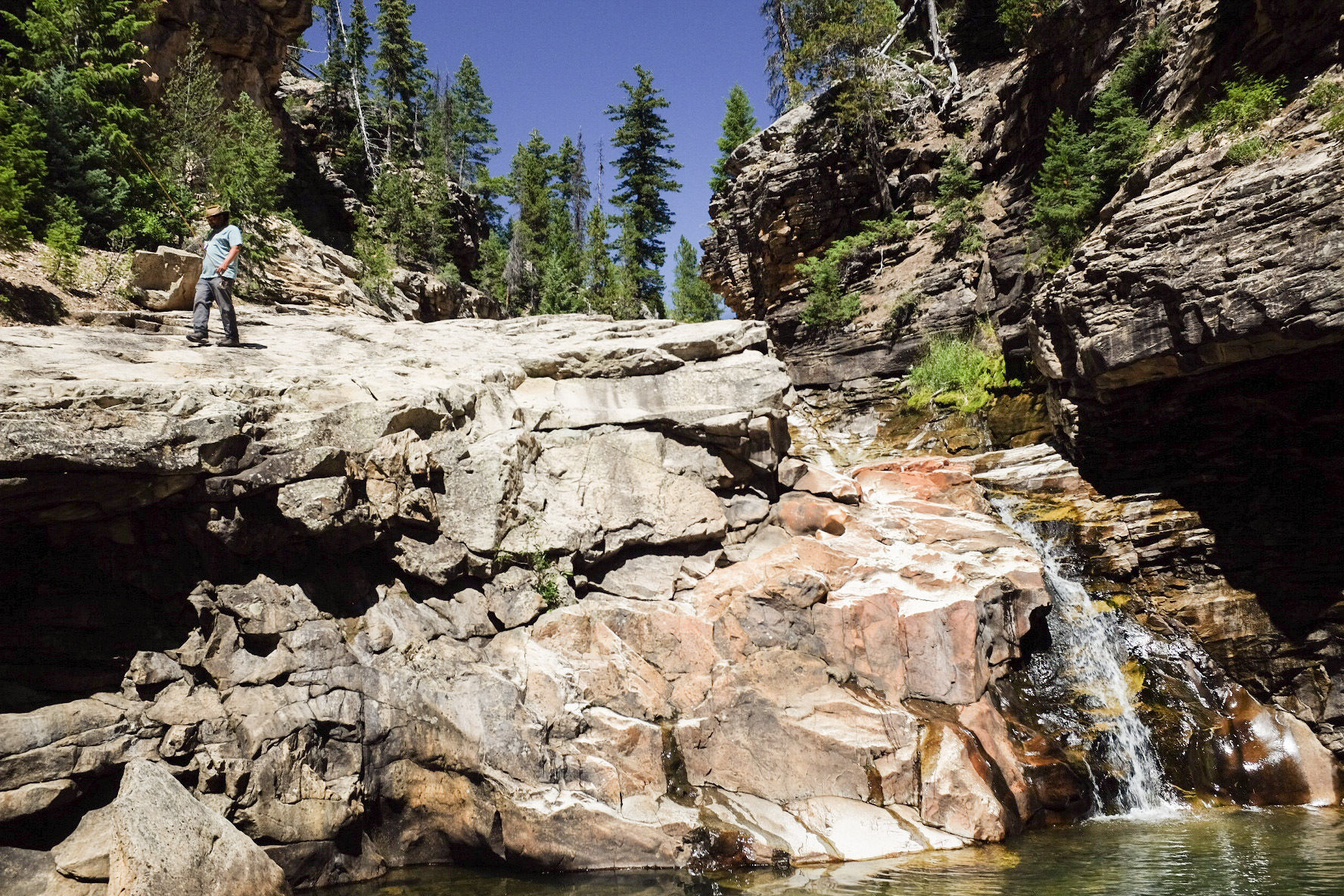
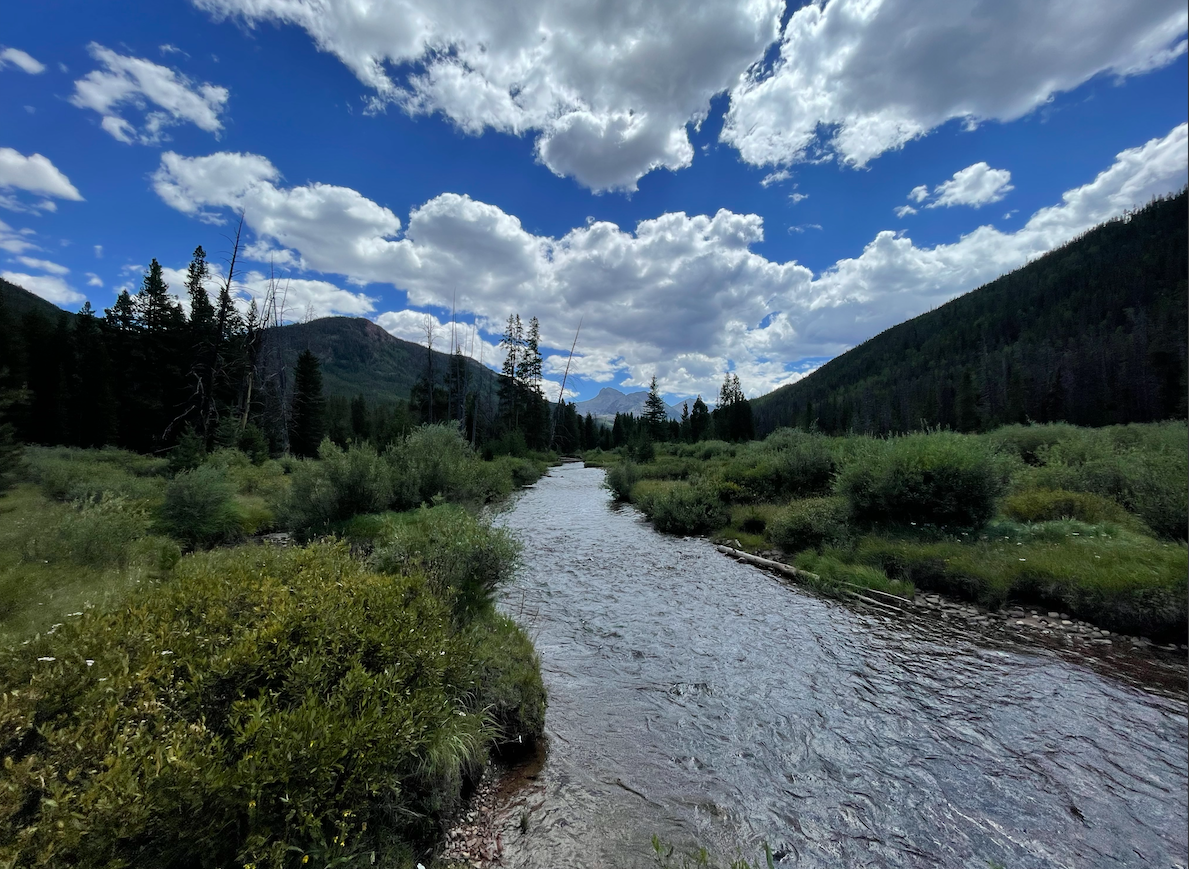
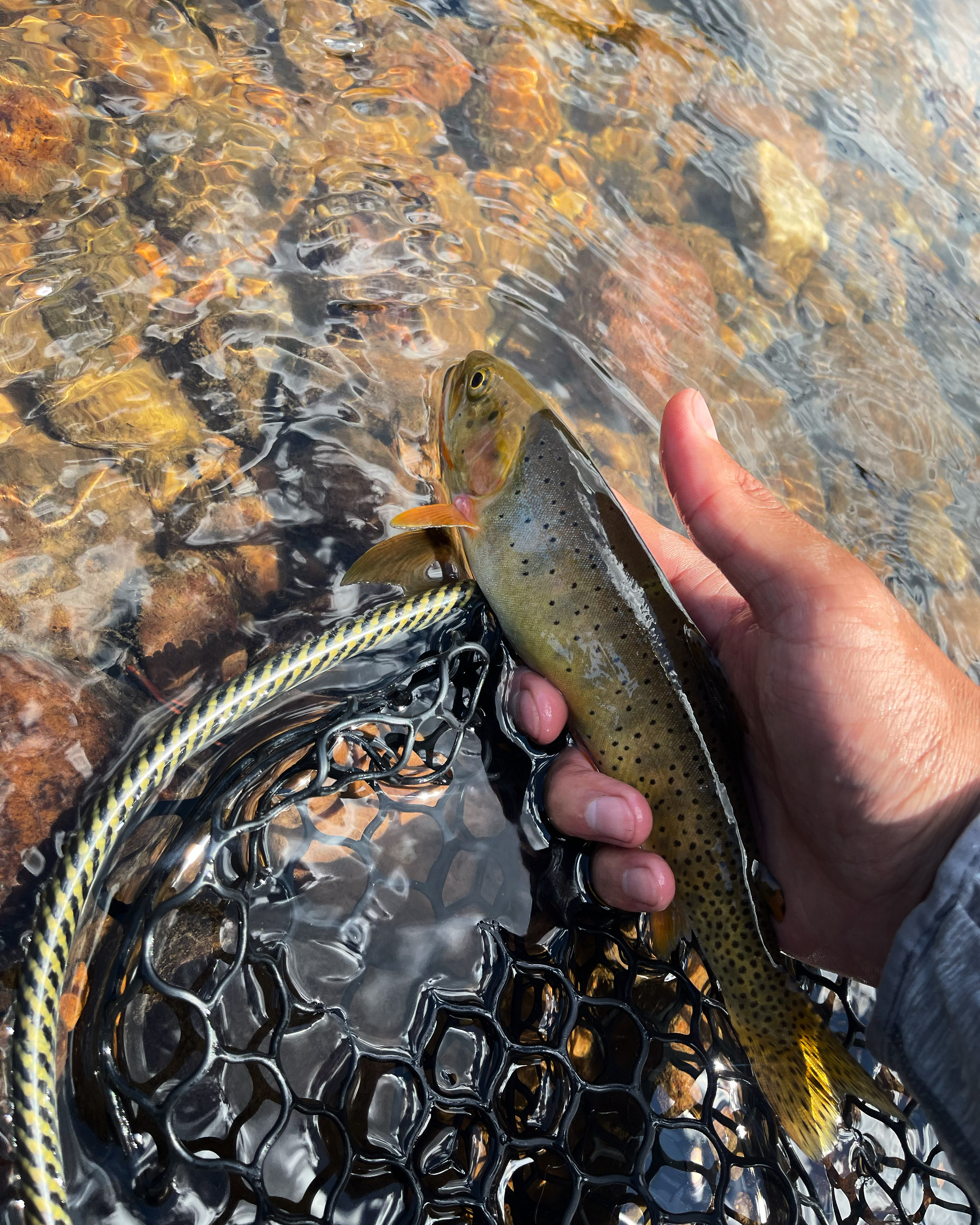
Runs, riffles, plunge pools, pockets and pillows! High country streams offer all sorts of holding water for trout and catching a fish in such unique settings only adds to the experience.
What size rod & tackle should I be using?
Your go-to, all-around trout rod will work just fine in the high country, but like any aspect of fly-fishing, there are rods which are better suited for fishing the high country streams and lakes. We at the shop love to fish 3 weight or 4 weight fiberglass fly rods in 7’-8’ lengths in the high country streams. Why? Because they excel at fishing and casting in tight quarters, and make every fish you catch more fun-regardless of size. Fiberglass fly rods like the Scott F Series, Orvis Superfine Glass rods, or Redington Butter Stick are all excellent choices to consider, and will make fishing these smaller waters a more enjoyable experience.
For fishing the high country lakes, where you may want to fish the inlet and/or outlet streams, and need to make longer casts or fish a variety of flies when fishing the lakes, a 4 weight graphite fly rod 8’-9’ length is a great choice to consider. The longer rod will make casting further easier, and a modern 4 weight is capable of fishing a variety of different flies, but still makes catching smaller fish fun. Some of our shop favorite 4 weight fly rods are the Sage Classic R8 in either the 8’6” 4 weight or 9’ 4 weight, the R.L. Winston Pure 2 7’9” or 8’3”’ 4 weight, and the Scott G Series in the 844, 884, or 904 models would all be good options for this kind of fishing.
As far as leaders and tippets go, I keep it simple. My go to Summer leaders are 7.5’ 4X leaders for the creeks and streams, and 9’ 4X leaders for the lakes. It is rare that you’ll need to fish a fly larger than a #10 in this kind of water, and a 4X leader with 4X-6X tippet spools allows you to fish the larger flies, and adjust to a variety of fishing situations with relative ease.

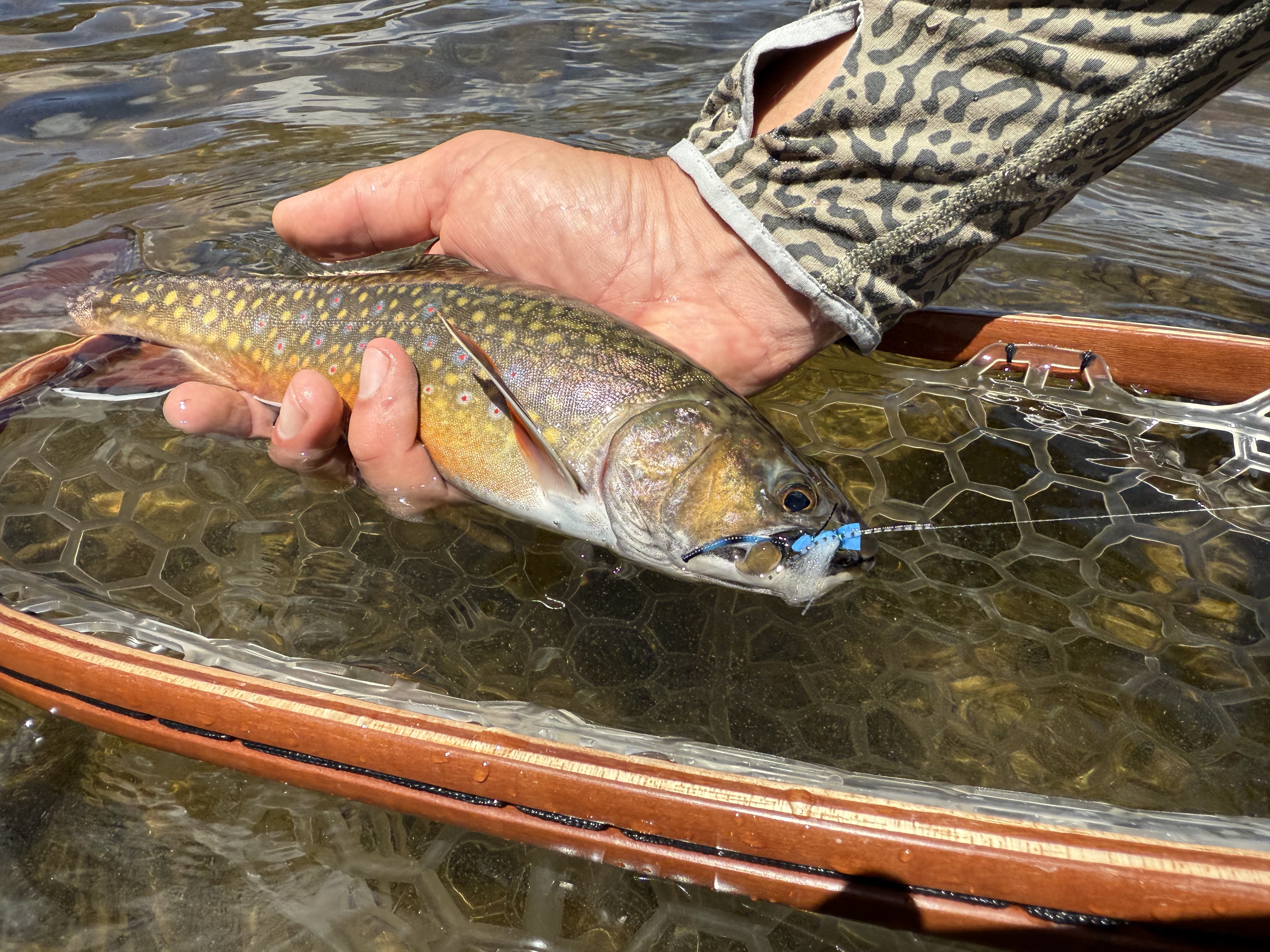
Leeches, damsels and foam. Short feeding seasons force these fish to be more opportunistic toward their food sources. Cover water; finding fish can be more important than which fly you actually present to them.
What hatches may I see, and what kind of fly patterns should I be prepared with?
There are definitely insect hatches to be prepared for in the high country. Depending on the elevation, you can find midges, damselflies, and Callibaetis mayflies hatching in the lakes, and the creeks and streams definitely get hatches of mayflies, caddis, and stoneflies. Additionally, the mountain winds will blow ants, beetles and hoppers into the water. The good news for both high country lake and stream anglers, is that it’s rarely necessary to have exact fly imitations to mimic the insects the fish are feeding on. Due to the relatively short fishing season in the high country, fish that live there don’t have the luxury of being able to refuse food, because the insect hatches are not nearly as consistent or long lived as they are on our local tailwaters. As a result, the trout in the high country are much more willing to eat your flies. Some of our favorite go-to flies for both high country lakes and streams are:
- Wooly Buggers, #10-#14
- BH Mini Leeches, #8-#10
- Hot Headed Leech, #8-#10
- Damselflies #10-#14
- Callibaetis #14-#16
- PMX, #12-#16
- Humpy’s, #14-#16
- Renegades, #14-#18
- Mosquito, #16-#20
- Parachute Adams, #14-#20
- Purple Roosters/Purple Haze, #14-18
- Ant & Beetle Patterns, #12-#18
- Chubby Chernobyl, #14-#16
- Zebra Midges, #14-#20
- Chironomids #12-#16
- Damselfly Nymph #12-#16
- Callibaetis #14-#16
- Prince Nymphs, #14-#16
- Pheasant Tail Nymphs. #16-#20
- Hares Ear Nymphs #16-#20
- Copper Johns #14-#18
- Rainbow Warriors, #16-#20
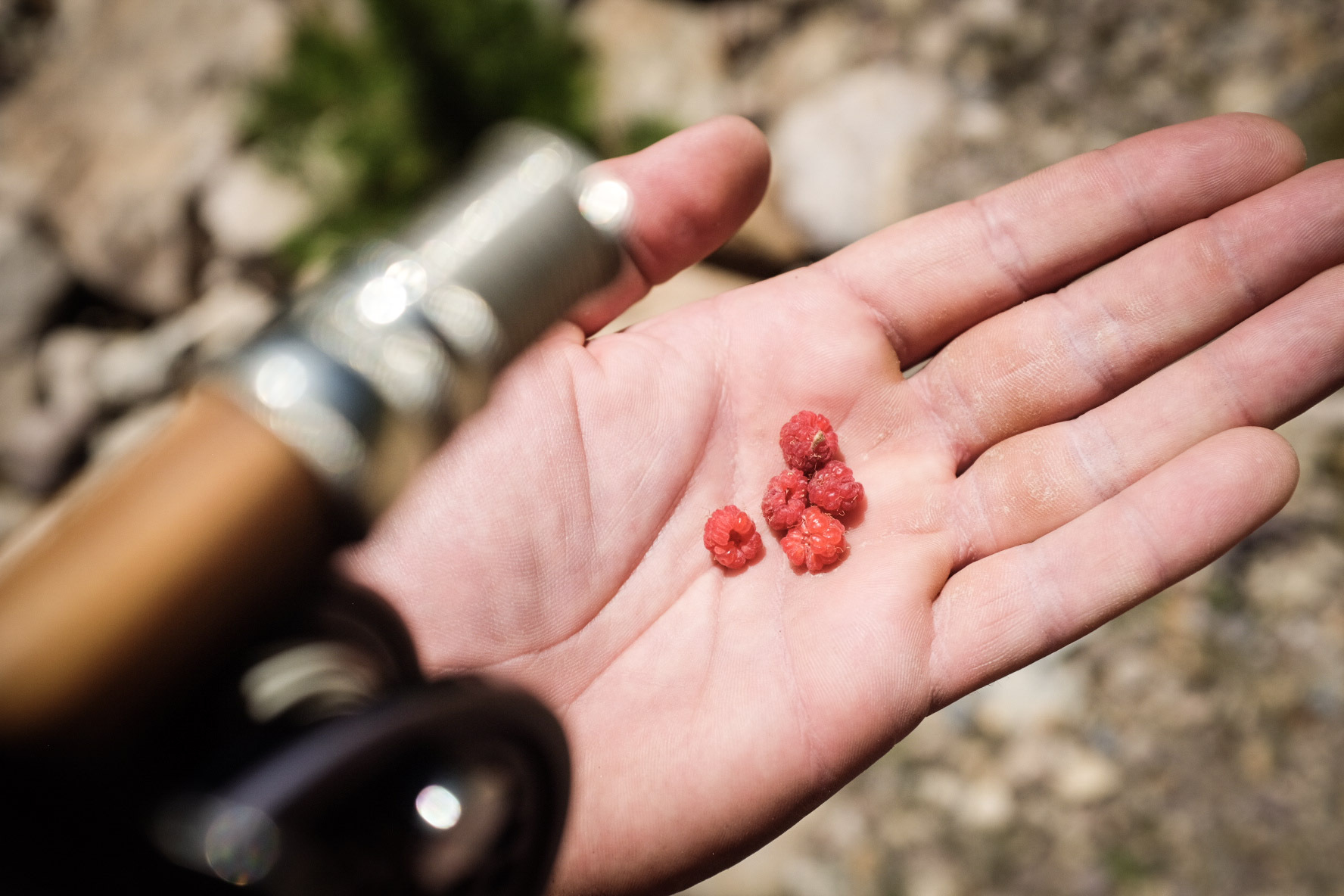
Never know what else you might find up there!


![[WR]F.A.Q - High Country [WR]F.A.Q - High Country](https://cdn11.bigcommerce.com/s-8uk8w4kj9b/images/stencil/460x250/uploaded_images/screen-shot-2025-08-05-at-9.34.34-am.png?t=1754429702)
